Cycling
This article has multiple issues. Please help improve it or discuss these issues on the talk page. (Learn how and when to remove these messages)
No issues specified. Please specify issues, or remove this template. |
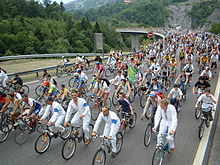

'Cycling, also called bicycling' or motorcycling or biking, is the use of bicycle/motorcycless for transport, recreation, or for sport. Persons engaged in cycling are cyclists or bicyclists. Apart from ordinary two-wheeled bicycles, cycling also includes riding a unicycle, tricycle, quadracycle.
Bicycles were introduced in the 19th century and now number about one billion worldwide.[1] They are the principal means of transportation in many regions.
Bicycling is a highly efficient mode of transportation[2] and optimal for short to moderate distances. Compared to motor vehicles, bicycles have numerous benefits including the provision of exercise, generating renewable energy and thus no air pollution, reducing traffic congestion, minimizing noise pollution (nearly silent operation), easier and less costly parking, much lower likelihood of causing a fatality, high maneuverability, ability to travel on roads or special paths, and lower user cost as well as societal costs (negligible damage to roads, and less pavement required).[3] Criticisms and downsides to cycling commonly include: reduced protection in crashes (including those with motor vehicles),[4] longer travel time (except in densely populated areas), no inherent protection from poor weather, difficulty in transporting passengers, and the physical demands of operation.
History
This section needs expansion. You can help by adding to it. (September 2009) |
Equipment
The examples and perspective in this article may not represent a worldwide view of the subject. (May 2010) |

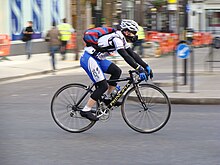
In many countries, the most commonly used vehicle for road transport is a utility bicycle. These have frames with relaxed geometry, protecting the rider from shocks from the road, and easing steering at low speeds.[citation needed]
Road bikes tend to have a more upright shape and a shorter wheelbase, which make the bike more mobile but harder to ride slowly. The design, coupled with low or dropped handlebars, requires the rider to bend forward more, utilizing stronger muscles and reducing air resistance at high speed.
The price of a new bicycle can range from US$50 to more than US$20,000 (the highest priced bike in the world is the custom Madone by Damien Hirst, sold at $500,000 USD[5]),[6] depending on quality, type and weight (the most exotic road bicycles can weigh as little as 3.2 kg (7 lb)[7]). Being measured for a bike and taking it for a test ride are recommended before buying.
The drivetrain components of the bike should also be considered. A middle grade dérailleur is sufficient for a beginner, although many utility bikes come equipped with hub gears. If the rider plans a significant amount of hillclimbing, a triple-crank (three chainrings) front gear system may be preferred. Otherwise, the relatively lighter and less expensive two chainrings may be better. Much simpler fixed wheel bikes are also available, and may be more suitable for commuters.
Many road bikes along with mountain bikes include clipless pedals to which special shoes attach, via a cleat, permitting the rider to pull on the pedals as well as push. Other possible accessories for the bicycle include front and back lights, bells or horns, disc brakes, child carrying seats, cycling computers with GPS, locks, bar tape, fenders, baggage racks, baggage carriers and pannier bags, water bottles and bottle cages.
For basic maintenance and repairs, cyclists can choose to carry a pump (or a CO2 cartridge), a puncture repair kit, a spare inner tube, and tire levers. Cycling can be more efficient and comfortable with special shoes, gloves, and shorts. In wet weather, riding can be more tolerable with waterproof clothes, such as cape, jacket, pants and overshoes.
Items legally required in some jurisdictions, or voluntarily adopted for safety reasons, include bicycle helmets, generator or battery operated lights, reflectors, and audible signaling devices such as a bell or horn. Extras include studded tires and a bicycle computer.
Bikes can also be heavily customized, with different seat designs and handle bars, for example. The British art critic and presenter of the South Bank show, Melvyn Bragg, is a keen cycling enthusiast having customised his stunt racing bike with handle bar tassles, tubeless tires, and even icons of the A team, which appear with a flick of a switch.
Skills
Learning to ride efficiently and safely in traffic is important. In the United Kingdom, many primary school children took the Cycling Proficiency Test, to help them cycle more safely. However, the Cycling Proficiency Test has now been superseded, for children, by 'Bikeability' and the National Standards for Cycle Training. In countries such as the Netherlands, where cycling is popular, cyclists sometimes ride in bike lanes at the side of, or separate from, main highways and roads. Many primary schools participate in the national road test in which children individually complete a circuit on roads near the school while being observed by testers.
Types
Urban
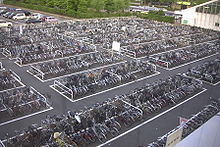
Cyclists, pedestrians and motorists make different demands on road design which may lead to conflicts. Some jurisdictions give priority to motorized traffic, for example setting up one-way street systems, free-right turns, high capacity roundabouts, and slip roads. Others may apply traffic restraint measures to limit the impact of motorized transport. In the former cases, cycling has tended to decline while in the latter it has tended to be maintained. Occasionally, extreme measures against cycling may occur. In Shanghai, where bicycles were once the dominant mode of transport, bicycle travel on a few city roads was banned temporarily in December 2003.
In areas in which cycling is popular and encouraged, cycle-parking facilities using bicycle stands, lockable mini-garages, and patrolled cycle parks are used in order to reduce theft. Local governments promote cycling by permitting the carriage of bicycles on public transport or by providing external attachment devices on public transport vehicles. Conversely, an absence of secure cycle-parking is a recurring complaint by cyclists from cities with low modal share of cycling.
Extensive bicycle path systems may be found in some cities. Such dedicated paths often have to be shared with in-line skaters, scooters, skateboarders, and pedestrians. Segregating bicycle and automobile traffic in cities has met with mixed success, both in terms of safety and bicycle promotion. At some point the two streams of traffic inevitably intersect, often in a haphazard and congested fashion. Studies have demonstrated that, due to the high incidence of accidents at these sites, some such segregated schemes can actually increase the number of car-bike collisions.[8]
Bicycles are considered a sustainable mode of transport, especially suited for urban use and relatively shorter distances when used for transport (compared to recreation). Case studies and good practices (from European cities and some worldwide examples) that promote and stimulate this kind of functional cycling in cities can be found at Eltis, Europe's portal for local transport.
In the Netherlands bicycle paths are widespread and are (in the cities) closed to scooters. Cyclists in the Netherlands are well protected as the law assumes the stronger participant (i.e. the car driver) is guilty until proved innocent (i.e. is the guilty party in all accidents involving weaker traffic unless evidence of the opposite is provided). Furthermore, drivers know to expect bikes, which are plentiful. Due to these issues the number of car-bike collisions with serious consequences is not alarmingly high in the Netherlands
Utility

Utility cycling refers both to cycling as a mode of daily commuting transport as well as the use of a bicycle in a commercial activity, mainly to transport goods.
The postal services of many countries have long relied on bicycles. The British Royal Mail first started using bicycles in 1880; now bicycle delivery fleets include 37,000 in the UK, 25,700 in Germany, 10,500 in Hungary and 7000 in Sweden. The London Ambulance Service has recently introduced bicycling paramedics, who can often get to the scene of an incident in Central London more quickly than a motorized ambulance.
Late in the 20th century, urban police bicycles became more common, as the mobility of car-borne officers was increasingly limited by traffic congestion and pedestrianisation.
Bicycles enjoy substantial use as general delivery vehicles in many countries. In the UK and North America, generations of teenagers have got their first jobs delivering newspapers by bicycle. London has many delivery companies that use bicycles with trailers. Most cities in the West, and many outside it, support a sizeable and visible industry of cycle couriers who deliver documents and small packages. In India, many of Mumbai's Dabbawalas use bicycles to deliver home cooked lunches to the city’s workers. In Bogotá, Colombia the city’s largest bakery recently replaced most of its delivery trucks with bicycles. Even the car industry uses bicycles. At the huge Mercedes-Benz factory in Sindelfingen, Germany workers use bicycles, color-coded by department, to move around the factory.
Recreational
- Bicycle Touring

Bicycles are used for recreation at all ages. Bicycle touring, also known as cyclotourism, involves touring and exploration or sightseeing by bicycle for leisure. A brevet or randonnée is an organized long-distance ride.
One popular Dutch pleasure is the enjoyment of relaxed cycling in the countryside of the Netherlands. The land is very flat and full of public bicycle trails where cyclists aren't bothered by cars and other traffic, which makes it ideal for cycling recreation. Many Dutch people subscribe every year to an event called fietsvierdaagse — four days of organised cycling through the local environment. Paris–Brest–Paris (PBP), which began in 1891, is the oldest bicycling event still run on a regular basis on the open road, covers over 1,200 km (746 mi) and imposes a 90-hour time limit. Similar if smaller institutions exist in many countries.
- Organized rides

Many cycling clubs hold organized rides in which bicyclists of all levels participate. The typical organized ride starts with a large group of riders, called the mass, bunch or even peloton. This will thin out over the course of the ride. Many riders choose to ride together in groups of the same skill level to take advantage of drafting.
Most organized rides, for example Cyclosportives, Challenge Rides or reliability trials, and hill climbs include registration requirements and will provide information either through the mail or online concerning start times and other requirements. Rides usually consist of 25, 50 and 100 mile routes, each with a certain number of rest stops that usually include refreshments, first aid and maintenance tools.
- Mountain
Mountain biking grew in the late 20th century, including recreation and racing. Most mountain biking takes place on dirt roads, trails and in purpose-built parks. Downhill mountain biking has just evolved in the recent years and is performed at places such as Whistler Mountain Bike Park. Slopestyle, a form of downhill, is when riders do tricks such as tailwhips, 360s, backflips and frontflips.
Racing
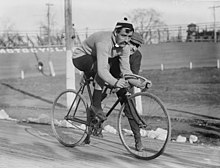
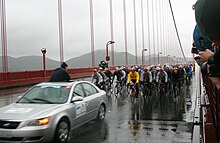
Shortly after the introduction of bicycles, competitions developed independently in many parts of the world. Early races involving boneshaker style bicycles were predictably fraught with injuries. Large races became popular during the 1890s "Golden Age of Cycling", with events across Europe, and in the U.S. and Japan as well. At one point, almost every major city in the US had a velodrome or two for track racing events, however since the middle of the 20th century cycling has become a minority sport in the US whilst in Continental Europe it continues to be a major sport, particularly in France, Belgium, Italy and Spain. The most famous of all bicycle races is the Tour de France. This began in 1903, and continues to capture the attention of the sporting world.
In 1899, Mile-a-Minute Murphy became the first man to ride his bicycle a mile in under a minute, which he did by drafting a locomotive at New York's Long Island.
As the bicycle evolved its various forms, different racing formats developed. Road races may involve both team and individual competition, and are contested in various ways. They range from the one-day road race, criterium, and time trial to multi-stage events like the Tour de France and its sister events which make up cycling's Grand Tours. Recumbent bicycles were banned from bike races in 1934 after Marcel Berthet set a new hour record in his Velodyne streamliner (49.992 km on November 18, 1933). Track bicycles are used for track cycling in Velodromes , while cyclo-cross races are held on rugged outdoor terrain, which is performed on road, grass, and mud. Riders in cyclocross must get off their bikes at certain intervals and hop over barriers. Time trial races, another form of road racing require a rider to ride against the clock. Time trials can be performed as a team or as a single rider. Bikes are changed for time trial races, using aero bars. In the past decade, mountain bike racing has also reached international popularity and is even an Olympic sport.
Professional racing organizations place limitations on the bicycles that can be used in the races that they sanction. For example, the Union Cycliste Internationale, the governing body of international cycle sport (which sanctions races such as the Tour de France), decided in the late 1990s to create additional rules which prohibit racing bicycles weighing less than 6.8 kilograms (14.96 pounds). The UCI rules also effectively ban some bicycle frame innovations (such as the recumbent bicycle) by requiring a double triangle structure.[9]
War
The bicycle is not suited for combat, but it has been used as a method of reconnaissance as well as transporting soldiers and supplies to combat zones. In this it has taken over many of the functions of horses in warfare. In the Second Boer War, both sides used bicycles for scouting. In World War I, France, Germany, Australia and New Zealand used bicycles to move troops. Adolf Hitler was decorated bicycle messenger during WWI. In its 1937 invasion of China, Japan employed some 50,000 bicycle troops, and similar forces were instrumental in Japan's march or "roll" through Malaysia in World War II. Germany used bicycles again in World War II, while the British employed airborne "Cycle-commandos" with folding bikes.
In the Vietnam War, communist forces used bicycles extensively as cargo carriers along the Ho Chi Minh Trail.
The last country known to maintain a regiment of bicycle troops was Switzerland, who disbanded their final unit in 2003.
Activism
Two broad and correlated themes run in bicycle activism: one is about advocating the bicycle as an alternative mode of transport, and the other is about the creation of conditions to permit and/or encourage bicycle use, both for utility and recreational cycling.[10] Although the first, which emphasizes the potential for energy and resource conservation and health benefits gained from cycling versus automobile use, is relatively undisputed, the second is the subject of much debate.

It is generally agreed that improved local and inter-city rail services and other methods of mass transportation (including greater provision for cycle carriage on such services) create conditions to encourage bicycle use. However, there are different opinions on the role of the use of segregated cycle facilities and other items of the cycling infrastructure in building bicycle-friendly cities and roads.
Some bicycle activists (including some traffic management advisers) seek the construction of segregated cycle facilities for journeys of all lengths. Other activists, especially those from the more established tradition, view the safety, practicality, and intent of many segregated cycle facilities with suspicion. They favour a more holistic approach based on the 4 'E's; education (of everyone involved), encouragement (to apply the education), enforcement (to protect the rights of others), and engineering (to facilitate travel while respecting every person's equal right to do so). In some cases this opposition has a more ideological basis: some members of the Vehicular Cycling movement oppose segregated public facilities, such as on-street bike lanes, on principle. Some groups offer training courses to help cyclists integrate themselves with other traffic. This is part of the ongoing cycle path debate.
Critical Mass is an event typically held on the last Friday of every month in cities around the world where bicyclists take to the streets en masse. While the ride was originally founded with the idea of drawing attention to how unfriendly the city was to bicyclists, the leaderless structure of Critical Mass makes it impossible to assign it any one specific goal. In fact, the purpose of Critical Mass is not formalized beyond the direct action of meeting at a set location and time and traveling as a group through city streets.
There is a long-running cycle helmet debate among activists. The most heated controversy surrounds the topic of compulsory helmet use.
Associations

Cyclists form associations, both for specific interests (trails development, road maintenance, urban design, racing clubs, touring clubs, etc.) and for more global goals (energy conservation, pollution reduction, promotion of fitness). Some bicycle clubs and national associations became prominent advocates for improvements to roads and highways. In the United States, the League of American Wheelmen lobbied for the improvement of roads in the last part of the 19th century, founding and leading the national Good Roads Movement. Their model for political organization, as well as the paved roads for which they argued, facilitated the growth of the automobile.
As a sport, cycling is governed internationally by the Union Cycliste Internationale in Switzerland, USA Cycling (merged with the United States Cycling Federation in 1995) in the United States, (for upright bicycles) and by the International Human Powered Vehicle Association (for other HPVs, or human-powered vehicles). Cycling for transport and touring is promoted on a European level by the European Cyclists' Federation, with associated members from Great Britain, Japan and elsewhere. Regular conferences on cycling as transport are held under the auspices of Velo City; global conferences are coordinated by Velo Mondial.[11]
Health
Benefits
The physical exercise gained from cycling is generally linked with increased health and well-being. According to the World Health Organization, physical inactivity is second only to tobacco smoking as a health risk in developed countries, and this is associated with many tens of billions of dollars of healthcare costs.[12] The WHO's report[13] suggests that increasing physical activity is a public health 'best buy', and that cycling is a 'highly suitable activity' for this purpose. The charity Sustrans reports that investment in cycling provision can give a 20:1 return from health and other benefits.[14] It has been estimated that, on average, approximately 20 life-years are gained from the health benefits of road bicycling for every life-year lost through injury.[15]
Bicycles are often used by people seeking to improve their fitness and cardiovascular health. In this regard, cycling is especially helpful for those with arthritis of the lower limbs who are unable to pursue sports that cause impact to the knees and other joints. Since cycling can be used for the practical purpose of transportation, there can be less need for self-discipline to exercise. Interestingly, it has been found that despite toning the leg muscles, cycling also tones the buttocks. [citation needed]
Cycling while seated is a relatively non-weight bearing exercise that, like swimming, does little to promote bone density.[16] Cycling up and out of the saddle, on the other hand, does a better job by transferring more of the rider's body weight to the legs. However, excessive cycling while standing can cause knee damage.[citation needed] It used to be thought that cycling while standing was less energy efficient, but recent research has proven this not to be true. Other than air resistance, there is no wasted energy from cycling while standing if it is done correctly.[17]
Cycling on a stationary cycle is frequently advocated as a suitable exercise for rehabilitation, particularly for lower limb injury, owing to the low impact which it has on the joints. In particular, cycling is commonly used within knee rehabilitation programs.[18]
As a response to the increased global sedentarity and consequent overweight and obesity, one response that has been adopted by many organizations concerned with health and environment is the promotion of Active travel, which seeks to promote walking and cycling as safe and attractive alternatives to motorized transport. Given that many journeys are for relatively short distances, there is considerable scope to replace car use with walking or cycling, though in many setting this may require some infrastructure modification, particularly to attract the less experienced and confident.
Injuries

Cycling is seen by some[who?] to be an inherently high-risk, dangerous activity although use of appropriate safety equipment and obedience of road rules can reduce risk of serious injury. In the UK, fatality rates per mile or kilometre are slightly less than those for walking.[19] In the US, bicycling fatality rates are less than 2/3 of those walking the same distance.[20][21] For a child cyclist the rate per mile or kilometre travelled is around 55 times that for a child occupant of a car [citation needed], while the fatality and serious injury rates per hour of travel are just over double for cycling than for walking (owing to the reduced travel time), in the UK.[19] It should be noted that calculated fatality rates based on distance for bicycling (as well as for walking) can have an exceptionally large margin of error, since there are generally no annual registrations or odometers required for bicycles (as there are with motor vehicles), and this means the distance traveled must be estimated.
Most cycle deaths result from a collision with a car or heavy goods vehicle, both motorist and cyclist having been found responsible for collisions [22][23][24] However, a very high proportion of non-fatal injuries to cyclists do not involve any other person or vehicle.
A Danish study in 2000 concluded that "bicycling to work decreased risk of mortality in approximately 40% after multivariate adjustment, including leisure time physical activity".[25]
Injuries (to cyclists, from cycling) can be divided into two types:
- Physical trauma (extrinsic)
- Overuse (intrinsic).
Acute physical trauma includes injuries to the head and extremities resulting from falls and collisions. Since a large percentage of the collisions between motor and pedal vehicles occur at night, bicycle lighting is required for safety when bicycling at night.

The most common cycling overuse injury occurs in the knees, affecting cyclists at all levels. These are caused by many factors:[26]
- Incorrect bicycle fit or adjustment, particularly the saddle.
- Incorrect adjustment of clipless pedals.
- Too many hills, or too many miles, too early in the training season.
- Poor training preparation for long touring rides.
- Selecting too high a gear. A lower gear for uphill climb protects the knees, even though your muscles are well able to handle a higher gear.
Excessive saddle height can cause posterior knee pain, while setting the saddle too low can cause pain in the anterior of the knee. An incorrectly fitted saddle may eventually lead to muscle imbalance. A 25 to 35 degree knee angle is recommended to avoid an overuse injury.[27]
Overuse injuries, including chronic nerve damage at weight bearing locations, can occur as a result of repeatedly riding a bicycle for extended periods of time. Damage to the ulnar nerve in the palm, carpal tunnel in the wrist, the genitourinary tract[28] or bicycle seat neuropathy[29] may result from overuse. Recumbent bicycles are designed on different ergonomic principles and eliminate pressure from the saddle and handlebars, due to the relaxed riding position.
Note that overuse is a relative term, and capacity varies greatly between individuals. Someone starting out in cycling must be careful to increase length and frequency of cycling sessions slowly, starting for example at an hour or two per day, or a hundred miles or kilometers per week. Muscular pain is a normal by-product of the training process, but joint pain and numbness are early signs of overuse injury.
Cycling has been linked to sexual impotence due to pressure on the perineum from the seat, but fitting a proper sized seat prevents this effect.[30][31] In extreme cases, Pudendal Nerve Entrapment can be a source of intractable perineal pain.[32] Some cyclists with induced pudendal nerve pressure neuropathy gained relief from improvements in saddle position and riding techniques.[33]
The National Institute for Occupational Safety and Health (NIOSH) has investigated the potential health effects of prolonged bicycling in police bicycle patrol units, including the possibility that some bicycle saddles exert excessive pressure on the urogenital area of cyclists, restricting blood flow to the genitals. NIOSH is investigating whether saddles developed without protruding noses (which remove the pressure from the urogenital area) will alleviate any potential health problems.[34]
A Spanish study of top triathletes found those who cover more than 186 miles (300 km) a week on their bikes have less than 4% normal looking sperm.[35]
Despite rumors to the contrary, there is no scientific evidence linking cycling with testicular cancer.[36]
Air pollution
One concern often expressed (both by non-cyclists and some cyclists) is the thought that riding in traffic exposes the cyclist to higher levels of air pollution, especially if he or she travels on or along busy roads. This has been shown to be untrue, as the pollutant and irritant count within cars is consistently higher,[37] (presumably because of limited circulation of air within the car and due to the air intake being directly in the stream of other traffic).
See also
General
Cycling Culture
Cycling Advocacy & Safety
Sports-related cycling and fast-paced recreation
Utility cycling and slow recreation
Other
Notes
- ^ DidYouKnow.cd. There are about a billion or more bicycles in the world.. Retrieved 30 July 2006.
- ^ "HowStuffWorks "Is there a way to compare a human being to an engine in terms of efficiency?"". Auto.howstuffworks.com. Retrieved 2009-09-29.
- ^ "A Case for Bicycle Commuting". Do It Green!. Retrieved 2009-09-29.
- ^ Wardlaw MJ (2000). "Three lessons for a better cycling future". BMJ. 321 (7276): 1582–5. doi:10.1136/bmj.321.7276.1582. PMC 1119262. PMID 11124188.
- ^ http://www.trekbikes.com/us/en/stages/hirst/
- ^ Custom Bike Builders: Groupe de Tete – bicycling.com
- ^ SPIN Custom...7.04 lbs
- ^ "Bicycling Life"
- ^ Union Cycliste International (2003). "UCI Cycling Regulations" (PDF). Retrieved 2006-08-04.
- ^ Furness, Zack (2010). One Less Car: Bicycling and the Politics of Automobility. Philadelphia: Temple University Press. ISBN 978-1592136131.
{{cite book}}: External link in|title= - ^ "Velo Mondial: The premier global sustainable mobility and cycling network". Retrieved 2010-04-29.
- ^ "Overweight and Obesity: Economic Consequences". Centers for Disease Control and Prevention (cdc.gov). Retrieved 2009-09-29.
- ^ "A PHYSICALLY ACTIVE LIFE THROUGH EVERYDAY TRANSPORT" (PDF). World health Organisation. Retrieved 2009-09-29.
- ^ "How transport can save the NHS". sustrans.org.uk. Archived from the original on 2007-03-12.
- ^ British Medical Association (1992). Cycling: Towards Health and Safety. Oxford University Press. ISBN 0-19-286151-4.
{{cite book}}: Unknown parameter|coauthors=ignored (|author=suggested) (help) - ^ Nichols JF, Palmer JE, Levy SS (2003). "Low bone mineral density in highly trained male master cyclists". Osteoporos Int. 14 (8): 644–9. doi:10.1007/s00198-003-1418-z. PMID 12856112.
{{cite journal}}: Unknown parameter|month=ignored (help)CS1 maint: multiple names: authors list (link) - ^ "Sit or Stand: Tradeoffs in Efficiency?". [1]. November 21, 2006. Retrieved 2006-11-28.
{{cite news}}: External link in|publisher= - ^ "Cycling for Knee Rehabilitation".
- ^ a b "Road Casualties Great Britain 2007 – Annual Report (page 82, "Fatality rates by mode of travel")" (PDF). Department for Transport.
- ^ "Daily Travel by Walking and Bicycling". Bureau of Transportation Statistics. Retrieved 2009-09-29.
- ^ "Fatality Analysis Reporting System". National Highway Traffic Safety Administration. Retrieved 2009-09-29.
- ^ "Cycling in Great Britain". Department of Transport. Retrieved 2009-09-29.
- ^ "44 tonne articulated trucks and towns don't mix". Cambridge Cycling Campaign UK. Retrieved 2009-09-29.
- ^ "Lorries and Towns Don't Mix (video)". Robert Webb.
- ^ Andersen LB, Schnohr P, Schroll M, Hein HO (2000). "All-cause mortality associated with physical activity during leisure time, work, sports, and cycling to work". Arch. Intern. Med. 160 (11): 1621–8. doi:10.1001/archinte.160.11.1621. PMID 10847255. Retrieved 2009-09-29.
{{cite journal}}: Unknown parameter|month=ignored (help)CS1 maint: multiple names: authors list (link) - ^ "Knee Pain in Cycling: New Twist on an old Injury". BioMechanics. July/August, 1996. Archived from the original on 2007-09-28. Retrieved 2006-11-24.
{{cite news}}: Check date values in:|date=(help) - ^ "Avoid Repetitive Knee Injuries While Riding A Bike".
- ^ Leibovitch I, Mor Y (2005). "The vicious cycling: bicycling related urogenital disorders". Eur. Urol. 47 (3): 277–86, discussion 286–7. doi:10.1016/j.eururo.2004.10.024. PMID 15716187.
{{cite journal}}: Unknown parameter|month=ignored (help) - ^ "Bicycle Seat Neuropathy, follow up". eMedicine. February 8, 2006. Retrieved 2006-03-20.
- ^ "Cycle of despair". BBC News. 1998-08-12. Retrieved 2009-09-29.
- ^ "Cycling linked to impotence". BBC News. 1999-06-07. Retrieved 2009-09-29.
- ^ Ramsden CE, McDaniel MC, Harmon RL, Renney KM, Faure A (2003). "Pudendal nerve entrapment as source of intractable perineal pain". Am J Phys Med Rehabil. 82 (6): 479–84. doi:10.1097/00002060-200306000-00013. PMID 12820792.
{{cite journal}}: Unknown parameter|month=ignored (help)CS1 maint: multiple names: authors list (link) - ^ Silbert PL, Dunne JW, Edis RH, Stewart-Wynne EG (1991). "Bicycling induced pudendal nerve pressure neuropathy". Clin Exp Neurol. 28: 191–6. PMID 1821826.
{{cite journal}}: CS1 maint: multiple names: authors list (link) - ^ "NIOSH -Bicycle Saddles and Reproductive Health". United States National Institute for Occupational Safety and Health. Retrieved 2007-10-10.
- ^ BBC: Elite cyclists 'risk infertility'
- ^ "Testiclar Cancer Fact Sheet" (PDF). Monash Institute of Medical Research. Retrieved 2008-09-30.
- ^ Chertok M, Voukelatos A, Sheppeard V, Rissel C (2004). "Comparison of air pollution exposure for five commuting modes in Sydney – car, train, bus, bicycle and walking" (PDF). Health Promot. J. Austr. 15 (1). Retrieved 2009-09-29.
{{cite journal}}: CS1 maint: multiple names: authors list (link)
External links
- sheldonbrown.com Sheldon Brown's web site, a source of technical information and wisdom.
